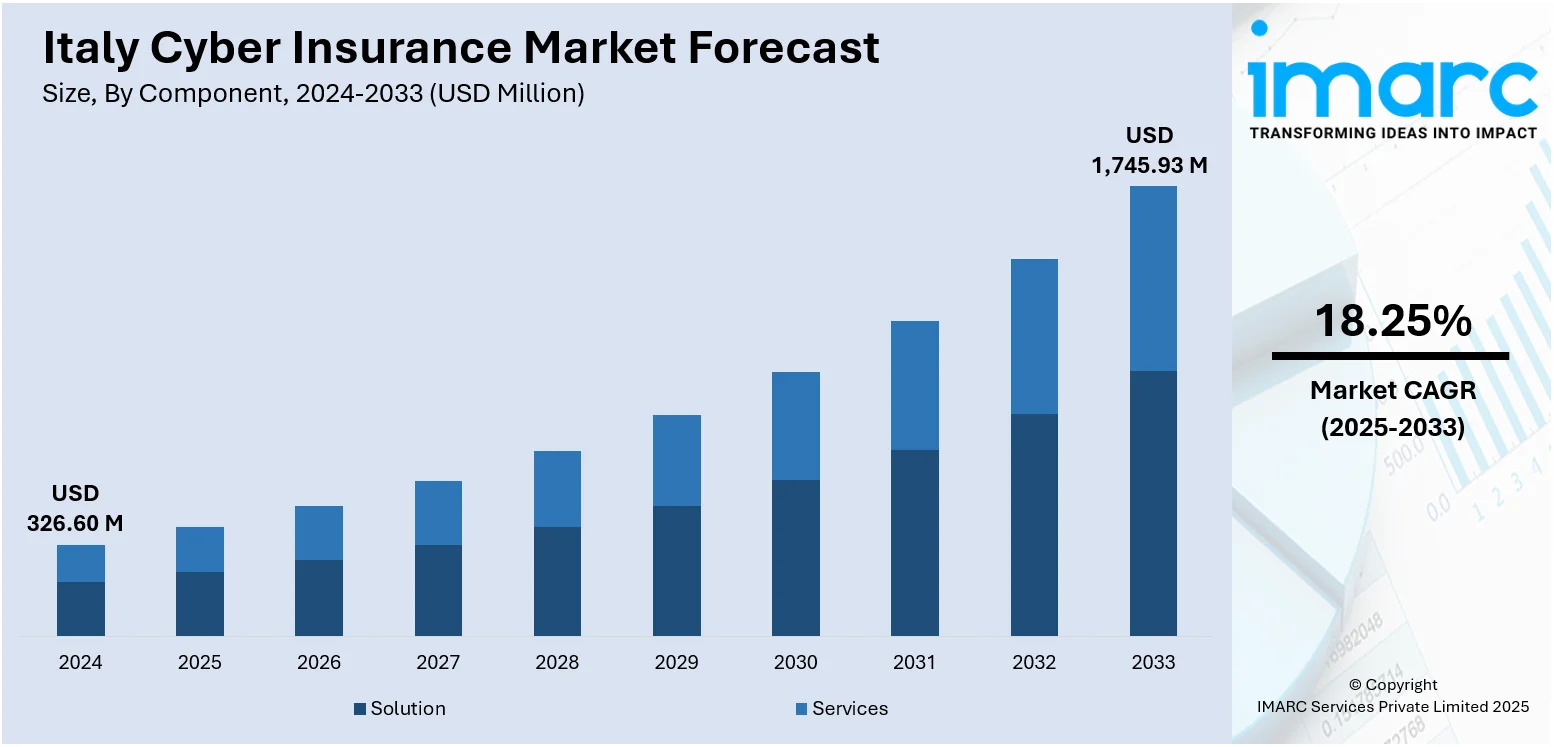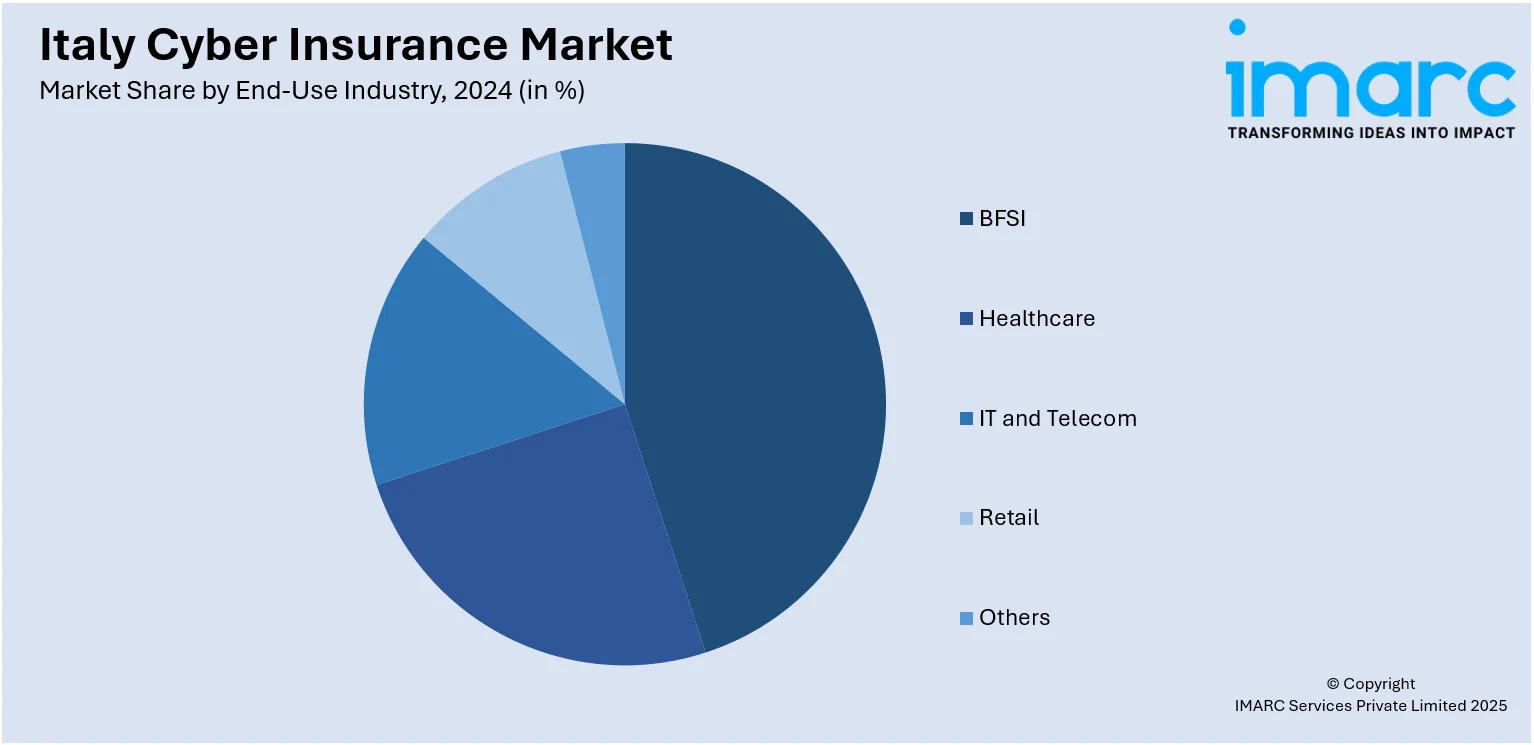
Italy Cyber Insurance Market Size, Share, Trends and Forecast by Component, Insurance Type, Organization Size, End-Use Industry, and Region, 2025-2033
Italy Cyber Insurance Market Overview:
The Italy cyber insurance market size reached USD 326.60 Million in 2024. The market is projected to reach USD 1,745.93 Million by 2033, exhibiting a growth rate (CAGR) of 18.25% during 2025-2033. Rising cases of data breaches, stricter compliance requirements, and increased adoption of digital platforms are boosting demand for cyber coverage. Advancements in risk assessment tools and tailored policies continue to strengthen Italy cyber insurance market share across various industry sectors.
|
Report Attribute
|
Key Statistics
|
|---|---|
|
Base Year
|
2024
|
|
Forecast Years
|
2025-2033
|
|
Historical Years
|
2019-2024
|
| Market Size in 2024 | USD 326.60 Million |
| Market Forecast in 2033 | USD 1,745.93 Million |
| Market Growth Rate 2025-2033 | 18.25% |
Italy Cyber Insurance Market Trends:
Rising Demand and Market Expansion
The Italy cyber insurance market growth is being fueled by the sharp rise in cyberattacks targeting both private and public sectors. Businesses are becoming more aware of the financial and reputational risks linked to data breaches, ransomware, and phishing scams. This awareness is pushing small enterprises, which previously overlooked cyber coverage, to seek insurance solutions alongside large corporations. Regulatory developments, including stricter data protection laws, have also prompted organizations to adopt robust risk management strategies, increasing demand for specialized policies. Recent years have seen insurers in Italy enhance policy offerings to cover a wider range of incidents, including business interruption losses and legal expenses. The market is also benefiting from the spread of remote work, which has created new vulnerabilities for hackers to exploit. Technological advancements in threat detection and assessment tools have enabled insurers to design tailored products, making coverage more accessible. These developments, combined with rising digitalization in finance, healthcare, and manufacturing, are creating a stronger base for steady market expansion.

To get more information on this market, Request Sample
Policy Innovation and Risk Mitigation Efforts
Growing sophistication of cyber threats is driving insurers in Italy to innovate in policy structures and claim support services. Many providers are now offering pre-breach consultation, employee training programs, and real-time monitoring assistance as part of their packages. This shift reflects a more proactive approach to risk mitigation, aiming to prevent losses before they occur. Partnerships between insurers and cybersecurity firms have become more common, enabling faster incident response and forensic analysis after a breach. Additionally, the increased use of AI in underwriting allows insurers to better assess the specific risk profile of each client, leading to more accurate pricing. Recent market developments include the introduction of sector-specific policies tailored to industries with higher exposure, such as finance and e-commerce. As awareness spreads among medium-sized enterprises, uptake rates are climbing, further widening the insured base. The push for comprehensive protection is also coming from global supply chain integration, where a single breach can disrupt multiple partners. With growing pressure from investors and customers for better data security, insurers are expected to continue refining coverage terms, offering more flexible and responsive solutions in the years ahead.
Italy Cyber Insurance Market Segmentation:
IMARC Group provides an analysis of the key trends in each segment of the market, along with forecasts at the country and regional level for 2025-2033. Our report has categorized the market based on component, insurance type, organization size, and end-use industry.
Component Insights:
- Solution
- Services
The report has provided a detailed breakup and analysis of the market based on the component. This includes solution and services.
Insurance Type Insights:
- Packaged
- Stand-alone
The report has provided a detailed breakup and analysis of the market based on the insurance type. This includes packaged and stand-alone.
Organization Size Insights:
- Small and Medium Enterprises
- Large Enterprises
The report has provided a detailed breakup and analysis of the market based on the organization size. This includes small and medium enterprises and large enterprises.
End-Use Industry Insights:

- BFSI
- Healthcare
- IT and Telecom
- Retail
- Others
The report has provided a detailed breakup and analysis of the market based on the end-use industry. This includes BFSI, healthcare, IT and telecom, retail, and others.
Regional Insights:
- Northwest
- Northeast
- Central
- South
- Others
The report has also provided a comprehensive analysis of all the major regional markets, which include Northwest, Northeast, Central, South, and others.
Competitive Landscape:
The market research report has also provided a comprehensive analysis of the competitive landscape. Competitive analysis such as market structure, key player positioning, top winning strategies, competitive dashboard, and company evaluation quadrant has been covered in the report. Also, detailed profiles of all major companies have been provided.
Italy Cyber Insurance Market News:
- August 2025: Everest entered the Italian insurance market, offering cyber coverage alongside other specialty lines. The expansion broadened cyber insurance availability, enhanced local risk management solutions, and strengthened Italy’s position as a growing hub for tailored cybersecurity protection in the insurance sector.
Italy Cyber Insurance Market Report Coverage:
| Report Features | Details |
|---|---|
| Base Year of the Analysis | 2024 |
| Historical Period | 2019-2024 |
| Forecast Period | 2025-2033 |
| Units | Million USD |
| Scope of the Report |
Exploration of Historical Trends and Market Outlook, Industry Catalysts and Challenges, Segment-Wise Historical and Future Market Assessment:
|
| Components Covered | Solution, Services |
| Insurance Types Covered | Packaged, Stand-alone |
| Organization Sizes Covered | Small and Medium Enterprises, Large Enterprises |
| End-Use Industries Covered | BFSI, Healthcare, IT and Telecom, Retail, Others |
| Regions Covered | Northwest, Northeast, Central, South, Others |
| Customization Scope | 10% Free Customization |
| Post-Sale Analyst Support | 10-12 Weeks |
| Delivery Format | PDF and Excel through Email (We can also provide the editable version of the report in PPT/Word format on special request) |
Key Questions Answered in This Report:
- How has the Italy cyber insurance market performed so far and how will it perform in the coming years?
- What is the breakup of the Italy cyber insurance market on the basis of component?
- What is the breakup of the Italy cyber insurance market on the basis of insurance type?
- What is the breakup of the Italy cyber insurance market on the basis of organization size?
- What is the breakup of the Italy cyber insurance market on the basis of end-use industry?
- What is the breakup of the Italy cyber insurance market on the basis of region?
- What are the various stages in the value chain of the Italy cyber insurance market?
- What are the key driving factors and challenges in the Italy cyber insurance market?
- What is the structure of the Italy cyber insurance market and who are the key players?
- What is the degree of competition in the Italy cyber insurance market?
Key Benefits for Stakeholders:
- IMARC’s industry report offers a comprehensive quantitative analysis of various market segments, historical and current market trends, market forecasts, and dynamics of the Italy cyber insurance market from 2019-2033.
- The research report provides the latest information on the market drivers, challenges, and opportunities in the Italy cyber insurance market.
- Porter's Five Forces analysis assists stakeholders in assessing the impact of new entrants, competitive rivalry, supplier power, buyer power, and the threat of substitution. It helps stakeholders to analyze the level of competition within the Italy cyber insurance industry and its attractiveness.
- Competitive landscape allows stakeholders to understand their competitive environment and provides an insight into the current positions of key players in the market.
Need more help?
- Speak to our experienced analysts for insights on the current market scenarios.
- Include additional segments and countries to customize the report as per your requirement.
- Gain an unparalleled competitive advantage in your domain by understanding how to utilize the report and positively impacting your operations and revenue.
- For further assistance, please connect with our analysts.
 Request Customization
Request Customization
 Speak to an Analyst
Speak to an Analyst
 Request Brochure
Request Brochure
 Inquire Before Buying
Inquire Before Buying




.webp)




.webp)












